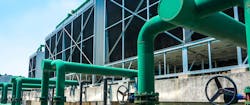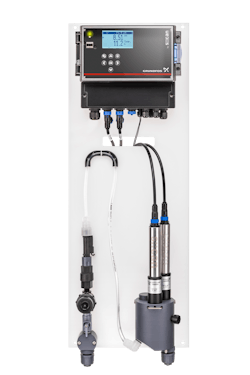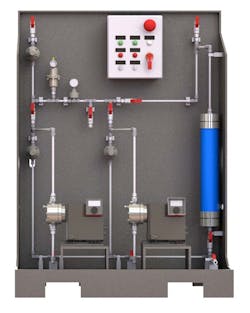Understand the risk of stagnant water to reopen with safety and reliability
The year 2020 has marked a time when the risk of disease has altered plans for how we work, shop, learn and travel. As the work force re-enters offices and more industrial and commercial facilities reopen, there looms another risk waiting in our water systems – Legionella.
Legionella bacteria is common in wet and humid environments where temperatures range from 77–108°F. Legionella bacteria can be the cause of two illnesses in humans: Legionnaires’ disease, an infection that produces pneumonia; and Pontiac fever, which resembles acute influenza. Infection occurs after inhaling a fine aerosol of contaminated water droplets. Typical sources of infection are cooling towers in large central air conditioning systems, whirlpools and showers.
Immediate Concerns
Disinfection residual levels are reduced by increased temperatures, high pH levels, mechanical processes that agitate the water and time sitting in a tank or pipe. Reduced disinfection levels in processes such as filtering, storing and heating can promote Legionella growth as residual levels decrease.1 It is important to control this by taking steps to add supplemental disinfectant to stop the growth of Legionella. During times of prolonged shut down, the bacterial growth gets worse.
Stagnant water is especially susceptible to this germ. And with many buildings and facilities having shut down or sharply reduced operations for several months, there is an abundance of stagnant water sitting in pipes all over the world. This stagnation encourages biofilm growth, reduces water temperatures to levels that allow Legionella growth and reduces levels of disinfectant.2 The use of water treatment techniques to control Legionella growth are especially important when water becomes stagnant.
The most common way to treat water at risk of spreading Legionella is with a strong dose of a biocide like chlorine dioxide (ClO2) or sodium hypochlorite in large doses or hyperchlorination. Using the proper dosing equipment to safely, accurately and reliably inject these highly concentrated or high volume chemicals is a must. Precise dosing equipment reduces the risk of underfeeding or overfeeding chemical. While the risk of underfeeding chemistry is leaving pipes untreated, overfeeding chemical can also be costly and leave too much disinfectant residual, which can be harmful to pipes and human consumption.
Digital dosing pumps are recommended in hyperchlorination applications because this type of pump will ensure accurate and smooth injection into the system. These pumps receive a signal from the flow meter or measurement and control system and almost continuously inject into the water using smart technology to control pump speed using a microprocessor-controlled stepper motor. This ensures that the right amount is accurately dosed throughout the entire hyperchlorination process.
Measurement and Control
As soon as the high levels of Chlorine or ClO2 enters the water, it will start reacting with organic material and attaching to any biofilm or bacteria formation. Because the organic content and flow might vary, the level of disinfectant in the water at a specific sampling point must be monitored. The sample runs through the measurement and control system measuring cell where a digital sensor is used to determine the residual level.
The measurement and control system sends an output signal to either the chemical pumps or the ClO2 generator to close the loop and increase or decrease the injection of disinfectant based on the water’s residual content and flow variations. Temperature and pH values are also displayed and tracked at the measurement and control system.
Dosing Systems
A complete package system solution can be advantageous if the idea is to get something up and running quickly or if a water treater is looking to mobilize a fleet of systems to specifically target a hyperchlorination initiative to support the reopening of facilities. Dosing Skid Systems come in many forms to meet targeted needs for precise chemical treatment. A compact system that is easy to install, start up and replicate for in multiple sites is also an advantage when looking for a good, scalable disinfection system. Systems that include digital dosing pumps and measurement and control systems optimize the footprint and cost while maintaining perfect chemical feed and monitoring.
Connectivity
Connected systems are more important than ever before. The ability to manage chemical feed equipment from a remote location optimizes service visits to focus on the sites that need the most attention and reduces unnecessary travel or on-site time. Digitally enabled pumps, measurement and control systems and complete packaged systems give asset managers the ability to focus on the collection of data, and act on the data being collected in an effective way. By using algorithms and the data collected, processes can be optimized much faster and can be controlled more efficiently — saving time, energy, chemicals and water.
Dashboards, like in the figure below, give the command center feel to keep a watchful eye on all systems no matter the geographic separation in one simple view. With upcoming innovations and product launches within the next year, Grundfos is continually enhancing the way businesses can work with data remotely.
Next Steps
As business and industries begin to increase production and reopen, partnering with a chemical dosing and disinfection expert is critical to ensuring the safety of workers, visitors and the public. Unmatched chemical dosing precision, measurement and control, and remote connectivity empower your staff to ensure that protecting workers and the public from the threat of one disease does not lead to the risk of another.
References
- Legionella Growth and Spread. (2018, April 30). Retrieved July 24, 2020, from cdc.gov/legionella/wmp/overview/growth-and-spread.html
- Legionella Growth and Spread. (2018, April 30). Retrieved July 24, 2020, from cdc.gov/legionella/wmp/overview/growth-and-spread.html
About the Author: Jared Gabel is business development manager for Grundfos USA. Learn more about Grundfos solutions for industrial water treatment and disinfection at grundfos.us/ind-water.



